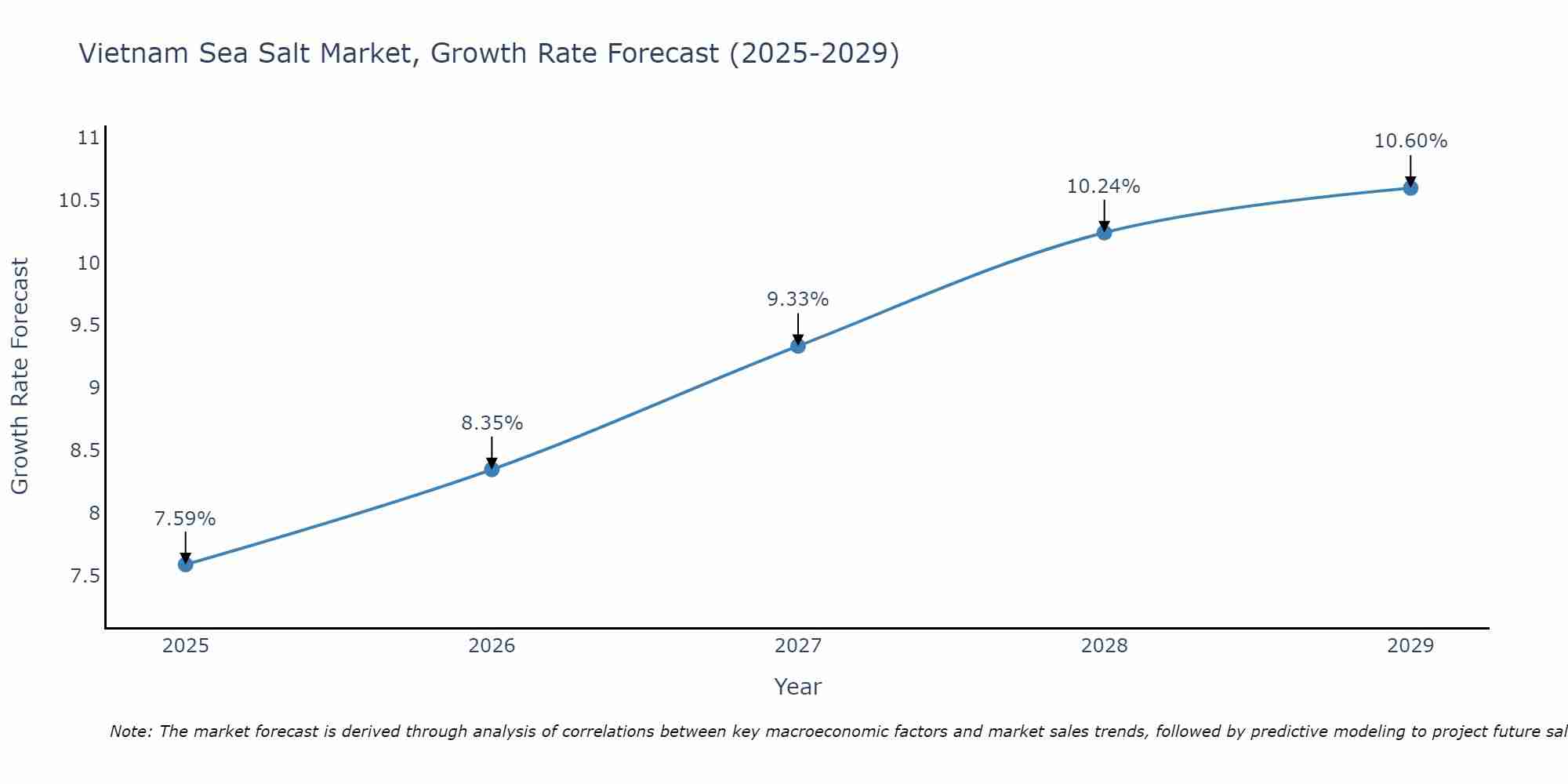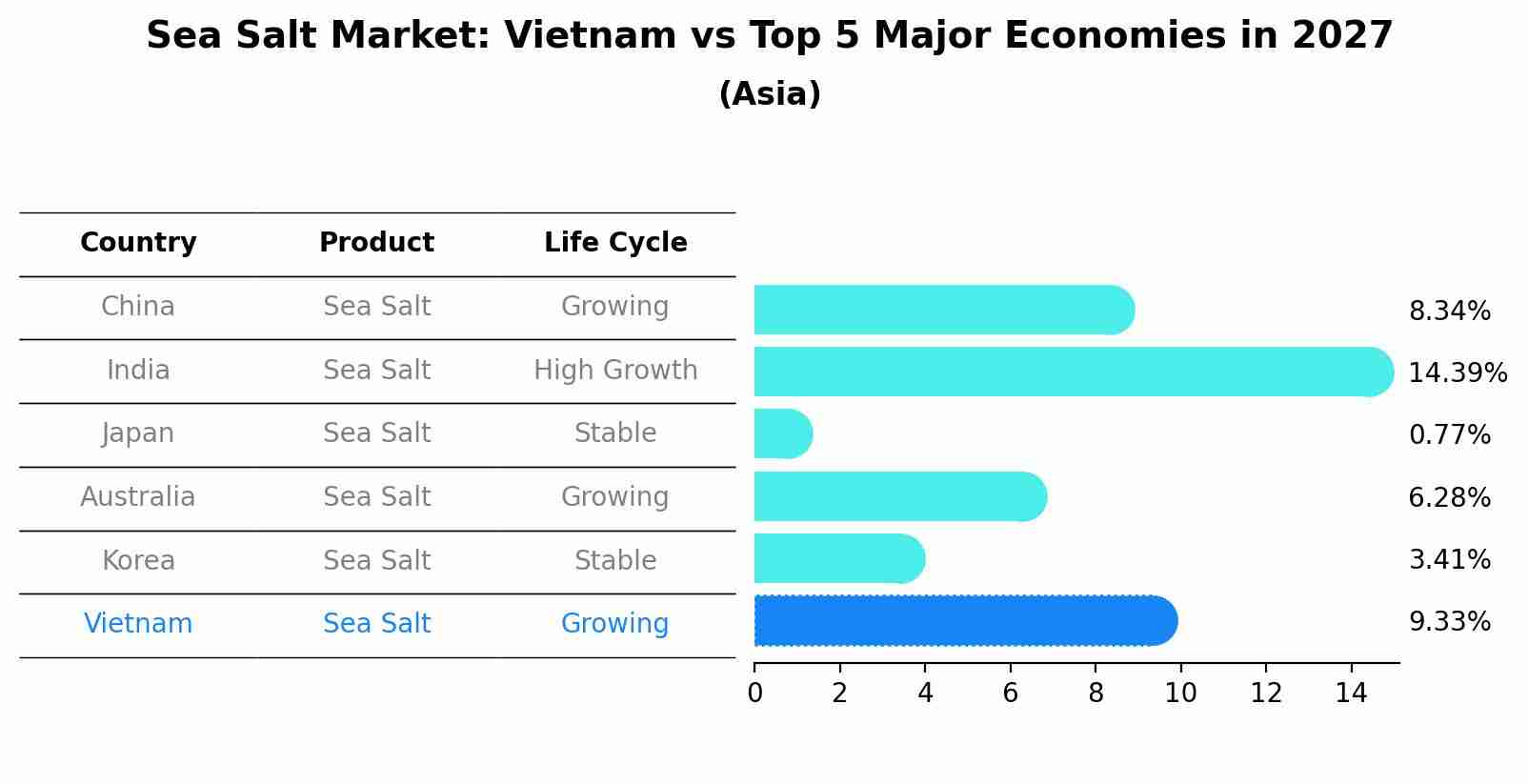Vietnam Sea Salt Market (2025-2031) Outlook | Companies, Share, Analysis, Value, Trends, Growth, Industry, Revenue, Forecast & Size
| Product Code: ETC304830 | Publication Date: Aug 2022 | Updated Date: Aug 2025 | Product Type: Market Research Report | |
| Publisher: 6Wresearch | Author: Ravi Bhandari | No. of Pages: 75 | No. of Figures: 35 | No. of Tables: 20 |
Vietnam Sea Salt Market Size Growth Rate
The Vietnam Sea Salt Market is poised for steady growth rate improvements from 2025 to 2029. Commencing at 7.59% in 2025, growth builds up to 10.60% by 2029.

Sea Salt Market: Vietnam vs Top 5 Major Economies in 2027 (Asia)
By 2027, the Sea Salt market in Vietnam is anticipated to reach a growth rate of 9.33%, as part of an increasingly competitive Asia region, where China remains at the forefront, supported by India, Japan, Australia and South Korea, driving innovations and market adoption across sectors.

Vietnam Sea Salt Market Synopsis
The Vietnam sea salt market is influenced by the country`s extensive coastline and traditional salt production methods. Sea salt is a staple in Vietnamese cuisine and is also used in various industrial applications. Traditional salt farms are still prevalent, but modernization and automation are slowly making inroads into the industry. Additionally, the export of Vietnamese sea salt to international markets is increasing, reflecting the quality and demand for this product. Sustainable salt production practices and quality standards are important factors for the Vietnam sea salt market`s continued growth.
Drivers of the Market
In addition, the Vietnam sea salt market is thriving as a result of the country`s abundant coastline and favorable climatic conditions for salt production. The increasing use of sea salt in the food industry and other applications has led to the expansion of sea salt production facilities, creating growth opportunities in the market.
Challenges of the Market
The Vietnam sea salt market encounters challenges related to environmental sustainability and market competitiveness. The traditional method of sea salt production can have adverse effects on coastal ecosystems and water quality. Balancing the preservation of natural habitats with the growing demand for sea salt requires innovative and environmentally friendly production methods. Additionally, competing with cheaper imported salt products can be a hurdle for domestic sea salt producers.
COVID-19 Impact on the Market
The Vietnam sea salt market, primarily serving domestic consumption and certain export markets, experienced shifts in demand during the pandemic. The closure of restaurants and reduced tourism had implications for salt consumption patterns. However, the market adapted by exploring new distribution channels and diversifying product offerings, including packaged salt for household use, to mitigate the impact of the pandemic.
Key Players in the Market
In the Vietnam sea salt market, well-established companies like Vietnam Saltworks Co., Saigon Salt Producers, and Hanoi Sea Salt Enterprises are key players. They are involved in the production and distribution of sea salt products.
Key Highlights of the Report:
- Vietnam Sea Salt Market Outlook
- Market Size of Vietnam Sea Salt Market, 2024
- Forecast of Vietnam Sea Salt Market, 2031
- Historical Data and Forecast of Vietnam Sea Salt Revenues & Volume for the Period 2021-2031
- Vietnam Sea Salt Market Trend Evolution
- Vietnam Sea Salt Market Drivers and Challenges
- Vietnam Sea Salt Price Trends
- Vietnam Sea Salt Porter's Five Forces
- Vietnam Sea Salt Industry Life Cycle
- Historical Data and Forecast of Vietnam Sea Salt Market Revenues & Volume By Distribution Channel for the Period 2021-2031
- Historical Data and Forecast of Vietnam Sea Salt Market Revenues & Volume By Direct/BB for the Period 2021-2031
- Historical Data and Forecast of Vietnam Sea Salt Market Revenues & Volume By Indirect/B2C for the Period 2021-2031
- Historical Data and Forecast of Vietnam Sea Salt Market Revenues & Volume By End Use for the Period 2021-2031
- Historical Data and Forecast of Vietnam Sea Salt Market Revenues & Volume By Agriculture for the Period 2021-2031
- Historical Data and Forecast of Vietnam Sea Salt Market Revenues & Volume By Cosmetics for the Period 2021-2031
- Historical Data and Forecast of Vietnam Sea Salt Market Revenues & Volume By Animal Feed for the Period 2021-2031
- Historical Data and Forecast of Vietnam Sea Salt Market Revenues & Volume By Horeca for the Period 2021-2031
- Historical Data and Forecast of Vietnam Sea Salt Market Revenues & Volume By Food Industry for the Period 2021-2031
- Vietnam Sea Salt Import Export Trade Statistics
- Market Opportunity Assessment By Distribution Channel
- Market Opportunity Assessment By End Use
- Vietnam Sea Salt Top Companies Market Share
- Vietnam Sea Salt Competitive Benchmarking By Technical and Operational Parameters
- Vietnam Sea Salt Company Profiles
- Vietnam Sea Salt Key Strategic Recommendations
Frequently Asked Questions About the Market Study (FAQs):
1 Executive Summary |
2 Introduction |
2.1 Key Highlights of the Report |
2.2 Report Description |
2.3 Market Scope & Segmentation |
2.4 Research Methodology |
2.5 Assumptions |
3 Vietnam Sea Salt Market Overview |
3.1 Vietnam Country Macro Economic Indicators |
3.2 Vietnam Sea Salt Market Revenues & Volume, 2021 & 2031F |
3.3 Vietnam Sea Salt Market - Industry Life Cycle |
3.4 Vietnam Sea Salt Market - Porter's Five Forces |
3.5 Vietnam Sea Salt Market Revenues & Volume Share, By Distribution Channel, 2021 & 2031F |
3.6 Vietnam Sea Salt Market Revenues & Volume Share, By End Use, 2021 & 2031F |
4 Vietnam Sea Salt Market Dynamics |
4.1 Impact Analysis |
4.2 Market Drivers |
4.2.1 Growing awareness about the health benefits of sea salt |
4.2.2 Increasing demand for organic and natural products |
4.2.3 Expansion of the food processing industry in Vietnam |
4.3 Market Restraints |
4.3.1 Competition from imported sea salt products |
4.3.2 Environmental concerns related to salt production methods |
4.3.3 Fluctuating prices of raw materials |
5 Vietnam Sea Salt Market Trends |
6 Vietnam Sea Salt Market, By Types |
6.1 Vietnam Sea Salt Market, By Distribution Channel |
6.1.1 Overview and Analysis |
6.1.2 Vietnam Sea Salt Market Revenues & Volume, By Distribution Channel, 2021-2031F |
6.1.3 Vietnam Sea Salt Market Revenues & Volume, By Direct/BB, 2021-2031F |
6.1.4 Vietnam Sea Salt Market Revenues & Volume, By Indirect/B2C, 2021-2031F |
6.2 Vietnam Sea Salt Market, By End Use |
6.2.1 Overview and Analysis |
6.2.2 Vietnam Sea Salt Market Revenues & Volume, By Agriculture, 2021-2031F |
6.2.3 Vietnam Sea Salt Market Revenues & Volume, By Cosmetics, 2021-2031F |
6.2.4 Vietnam Sea Salt Market Revenues & Volume, By Animal Feed, 2021-2031F |
6.2.5 Vietnam Sea Salt Market Revenues & Volume, By Horeca, 2021-2031F |
6.2.6 Vietnam Sea Salt Market Revenues & Volume, By Food Industry, 2021-2031F |
7 Vietnam Sea Salt Market Import-Export Trade Statistics |
7.1 Vietnam Sea Salt Market Export to Major Countries |
7.2 Vietnam Sea Salt Market Imports from Major Countries |
8 Vietnam Sea Salt Market Key Performance Indicators |
8.1 Percentage of market penetration in the food processing industry |
8.2 Number of new product launches using sea salt as an ingredient |
8.3 Consumer perception and awareness surveys regarding the benefits of sea salt |
9 Vietnam Sea Salt Market - Opportunity Assessment |
9.1 Vietnam Sea Salt Market Opportunity Assessment, By Distribution Channel, 2021 & 2031F |
9.2 Vietnam Sea Salt Market Opportunity Assessment, By End Use, 2021 & 2031F |
10 Vietnam Sea Salt Market - Competitive Landscape |
10.1 Vietnam Sea Salt Market Revenue Share, By Companies, 2024 |
10.2 Vietnam Sea Salt Market Competitive Benchmarking, By Operating and Technical Parameters |
11 Company Profiles |
12 Recommendations |
13 Disclaimer |
- Single User License$ 1,995
- Department License$ 2,400
- Site License$ 3,120
- Global License$ 3,795
Search
Thought Leadership and Analyst Meet
Our Clients
Related Reports
- Afghanistan Apparel Market (2026-2032) | Growth, Outlook, Industry, Segmentation, Forecast, Size, Companies, Trends, Value, Share, Analysis & Revenue
- Canada Oil and Gas Market (2026-2032) | Share, Segmentation, Value, Industry, Trends, Forecast, Analysis, Size & Revenue, Growth, Competitive Landscape, Outlook, Companies
- Germany Breakfast Food Market (2026-2032) | Industry, Share, Growth, Size, Companies, Value, Analysis, Revenue, Trends, Forecast & Outlook
- Australia Briquette Market (2025-2031) | Growth, Size, Revenue, Forecast, Analysis, Trends, Value, Share, Industry & Companies
- Vietnam System Integrator Market (2025-2031) | Size, Companies, Analysis, Industry, Value, Forecast, Growth, Trends, Revenue & Share
- ASEAN and Thailand Brain Health Supplements Market (2025-2031) | Strategy, Consumer Insights, Analysis, Investment Trends, Opportunities, Growth, Size, Share, Industry, Revenue, Segments, Value, Segmentation, Supply, Forecast, Restraints, Outlook, Competition, Drivers, Trends, Demand, Pricing Analysis, Competitive, Strategic Insights, Companies, Challenges
- ASEAN Bearings Market (2025-2031) | Strategy, Consumer Insights, Analysis, Investment Trends, Opportunities, Growth, Size, Share, Industry, Revenue, Segments, Value, Segmentation, Supply, Forecast, Restraints, Outlook, Competition, Drivers, Trends, Demand, Pricing Analysis, Competitive, Strategic Insights, Companies, Challenges
- Europe Flooring Market (2025-2031) | Outlook, Share, Industry, Trends, Forecast, Companies, Revenue, Size, Analysis, Growth & Value
- Saudi Arabia Manlift Market (2025-2031) | Outlook, Size, Growth, Trends, Companies, Industry, Revenue, Value, Share, Forecast & Analysis
- Uganda Excavator, Crane, and Wheel Loaders Market (2025-2031) | Strategy, Consumer Insights, Analysis, Investment Trends, Opportunities, Growth, Size, Share, Industry, Revenue, Segments, Value, Segmentation, Supply, Forecast, Restraints, Outlook, Competition, Drivers, Trends, Demand, Pricing Analysis, Competitive, Strategic Insights, Companies, Challenges
Industry Events and Analyst Meet
Whitepaper
- Middle East & Africa Commercial Security Market Click here to view more.
- Middle East & Africa Fire Safety Systems & Equipment Market Click here to view more.
- GCC Drone Market Click here to view more.
- Middle East Lighting Fixture Market Click here to view more.
- GCC Physical & Perimeter Security Market Click here to view more.
6WResearch In News
- Doha a strategic location for EV manufacturing hub: IPA Qatar
- Demand for luxury TVs surging in the GCC, says Samsung
- Empowering Growth: The Thriving Journey of Bangladesh’s Cable Industry
- Demand for luxury TVs surging in the GCC, says Samsung
- Video call with a traditional healer? Once unthinkable, it’s now common in South Africa
- Intelligent Buildings To Smooth GCC’s Path To Net Zero


















